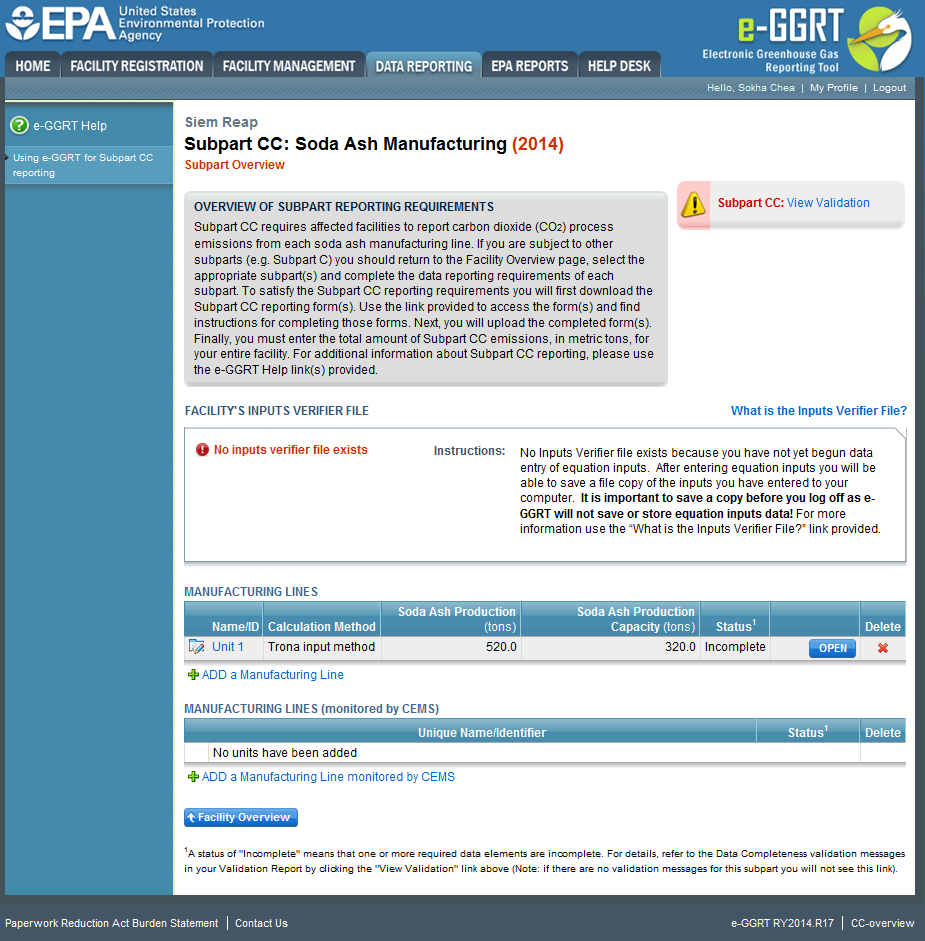This page provides an overview of subtopics that are central to Subpart CC reporting. This information will be entered from the e-GGRT Subpart CC Overview web form shown below. Each topic represents a key web form where you need to enter information.
- Facility Level Information
- Manufacturing Line for Units Not Monitored by CEMS
- Manufacturing Line for Units Monitored by CEMS
- Emission Information
- Emission Information for Manufacturing Units Monitored by CEMS
- Validation Report
The end of this page contains links you can use for more information on these topics.
The image below displays the Subpart CC Overview page.
Click image to expand
Facility Level Information
Subpart CC requires you to report the following data about your facility (Manufacturing Line):
- Total annual production of Soda Ash for manufacturing line
- Total annual production capacity of soda ash for the manufacturing line
Manufacturing Line for Units Not Monitored by CEMS
For each Manufacturing Line at your facility, report the following required in formation:
- A unique name or identifier for the unit, plus optional description for this facility (see also About Unique Unit Names)
- Calculation Method Used (from the dropdown menu)
- Annual production of soda ash for the manufacturing line
- Annual production capacity of soda ash for the manufacturing line
Manufacturing Line for Units Monitored by CEMS
For each Manufacturing Line monitored by a CEMS, report the following required information:
- A unique name or identifier for the unit, plus optional description for this facility (see also About Unique Unit Names)
- Annual production of soda ash for the manufacturing line
- Annual production capacity of soda ash for the manufacturing line
- Annual consumption of liquid alkaline for the manufacturing line
Emissions Information
- Annual CO2 mass emissions for the manufacturing line
Emissions Information for Manufacturing Line Monitored by CEMS
The required emissions information and the manner by which required emissions information is entered into e-GGRT is different for units that are monitored by a Continuous Emissions Monitoring System (CEMS) and units that are NOT monitored by a CEMS.
As a result, separate help content has been created in this subpart for entering emissions information for units monitored by CEMS and units NOT monitored by CEMS.
For each process unit that is NOT monitored by CEMS at your facility, the following emissions information is required on a monthly basis:
- Annual CO2 mass emissions for the soda ash manufacturing line
For each CEMS Monitoring Location, provide the following information:
- A unique unit name or identifier for the CML (see also About Unique Unit Names)
- An optional description or label for the CML
- The configuration of processes or process units that are monitored by the CML:
- Single process or process unit that exhausts to a dedicated stack
- Multiple processes or process units that share a common stack
- Process or process unit that shares a common stack with one or more stationary fuel combustion units
- The name of each fuel combusted in the unit(s) monitored by the CEMS
- The Tier 4/CEMS methodology start and end dates
- The cumulative total of hourly CO2 mass emissions for each quarter of the reporting year (metric tons) (Do not cumulate emissions data between quarters)
- The total annual CO2 mass emissions measured by the CEMS (metric tons)
- An indication whether emissions reported for the CEMS include emissions calculated according to 98.33(a)(4)(viii) for a slipstream that bypassed the CEMS
- The total annual biogenic CO2 emissions from the combustion of all biomass fuels combined (metric tons) (if applicable)
- The total annual non-biogenic CO2 emissions which includes fossil fuel, sorbent, and process CO2 emissions (metric tons)
- The total annual CH4 and N2O emissions associated with the combustion of all Table C-2 fuels combusted in all processes/process units monitored by the CEMS derived from application of Equation C-10 (metric tons) (if there are no combustion emissions in this CML, please enter zero)
- The total number of source operating hours in the reporting year
- The total operating hours in which a substitute data value was used in the emissions calculations for the CO2 concentration parameter
- The total operating hours in which a substitute data value was used in the emissions calculations for the stack gas flow rate parameter
- If moisture correction is required and a continuous moisture monitor is used, the total operating hours in which a substitute data value was used in the emissions calculations for the stack gas moisture content parameter
- An indication of the process units monitored by the CML
Do not leave any of these fields blank. If, for example, your facility has no biogenic CO2 emissions, enter 0.
Validation Report
The Validation Report assists you with determining the completeness and quality of your reporting data.
We strongly encourage you to use the Validation Report to check your work. The Validation Report performs two types of checks:
- Data Completeness: Data required for reporting that are missing or incomplete.
- Data Quality: Data that are outside of the expected range of values.
Certain validation checks which are considered to represent critical errors must be corrected before you can successfully generate and submit your Annual Report. These checks are signified with a stop sign . If you feel that you have triggered one of these checks in error, or if there’s a reason why your report should be submitted despite the check being triggered, please submit a request to the e-GGRT Help Desk at GHGReporting@epa.gov.
You may view the Validation Report at any time.



